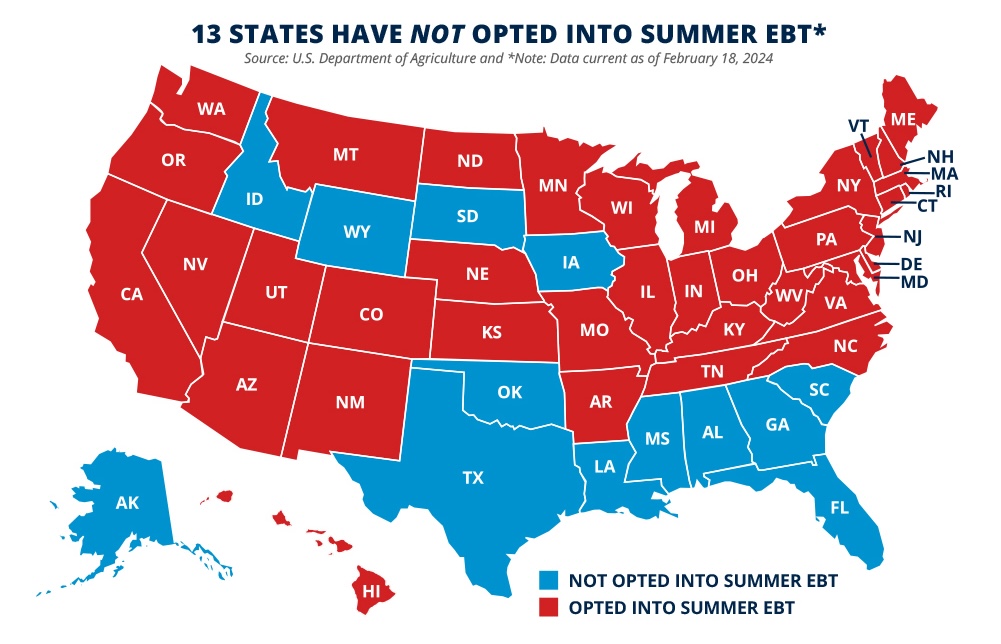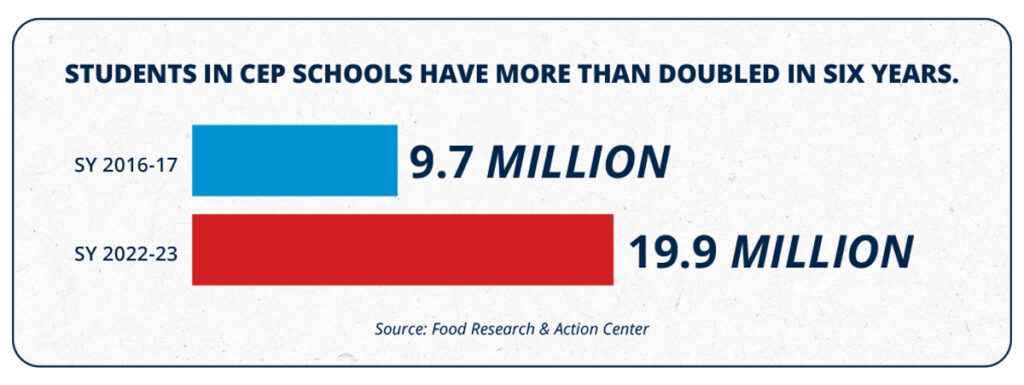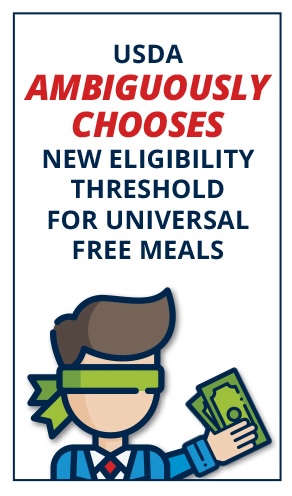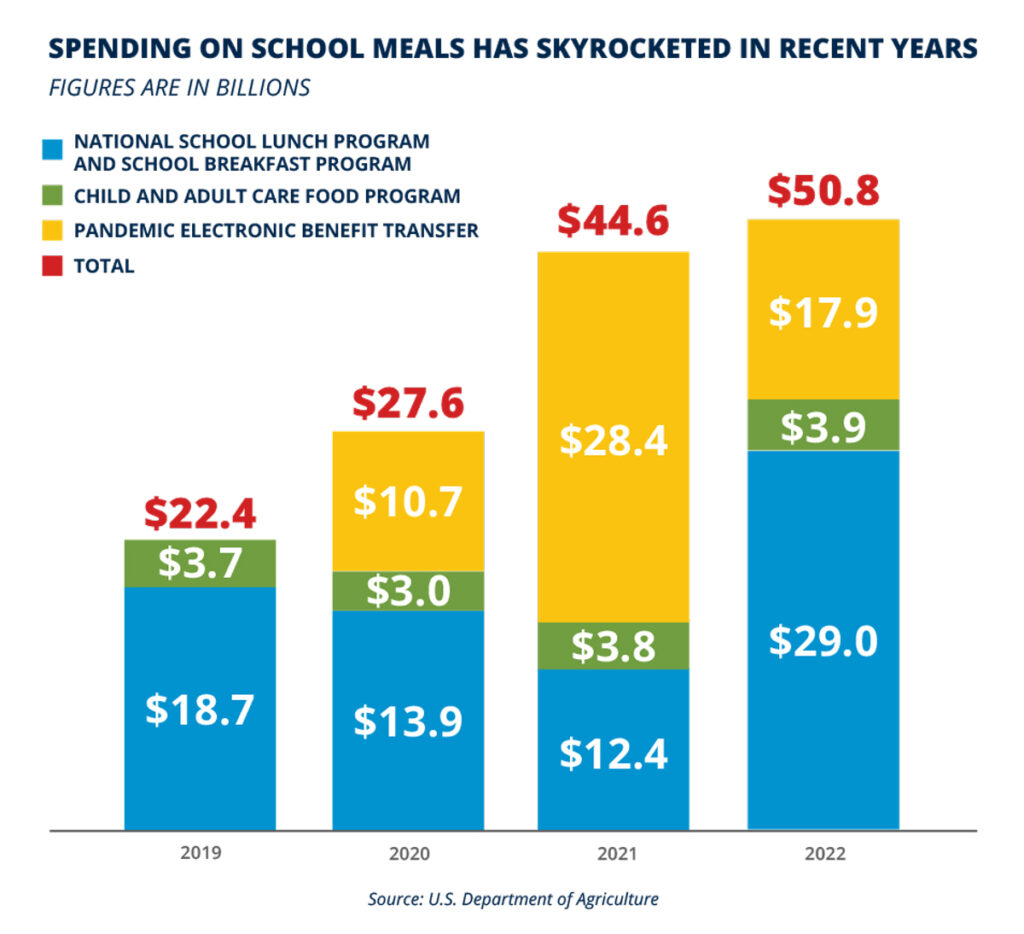The School Meal Free-for-All is a Bad Deal for States and Students
KEY FINDINGS
- Biden bureaucrats worked with Congress to transform the “temporary” summer taxpayer-funded lunch initiative into a permanent program.
- President Biden’s USDA ambiguously expanded eligibility for the school meal program.
- Food stamp boosts are already costing taxpayers billions, and this giveaway makes matters worse while doing nothing to help the truly needy.
Background
The pandemic is over, but some pandemic-era programs are here to stay. When state governments shuttered schools during COVID-19, agencies mailed Electronic Benefits Transfer (EBT) cards to households with children who lost access to taxpayer-funded meals during the school year.1 This extended into the summer months in some states as part of a temporary program.2
But beginning in summer 2024, states have the option to provide permanent food stamp benefits to school children year-round.3 Paired with recent bureaucratic action from President Biden’s U.S. Department of Agriculture (USDA), the taxpayer-funded, year-round school meal program could now be available to middle- and high-income students.4 This giveaway would allow students from middle and high-income families to depend on the government for their meals before they leave the nest. By dramatically lowering eligibility standards, taxpayer-funded meals would be available to millions of students, not just those with a true need.
This is not about childhood hunger. This is a massive taxpayer-funded food stamp expansion for those who do not need it.

Biden bureaucrats worked with Congress to transform the “temporary” summer taxpayer-funded lunch initiative into a permanent program.
Leaders on the Left could not let a crisis go to waste. In 2021, summer benefits were added to the pandemic food stamp expansion, in a program called Pandemic Electronic Benefit Transfer (P-EBT), giving states the option to provide EBT cards to students during the summer months.5 This “temporary” program began during COVID-19, though summer EBT programs have been piloted since 2011.6 Never mind that state governments themselves drove businesses to close during the pandemic, launching massive unemployment that led to instability for many families.7

Bureaucrats ironically stepped in, claiming to be magnanimous, but in reality, they sought to expand the program to those without a true need. President Biden’s Deputy Under Secretary for USDA’s Food, Nutrition, and Consumer Services Stacy Dean said of Summer EBT, “help is here for financially stressed families trying to put food on the table.”8 Ms. Dean has a long history of pushing proposals to increase food stamp benefits and expand welfare.9 Unfortunately, Summer EBT is no exception and will not benefit those in true need.

In 2022, Biden bureaucrats worked with Congress to expand welfare and make this temporary pandemic food stamp program permanent.10 Beginning in summer 2024, students will have access to taxpayer-funded meals year-round.11 Anyone who is directly certified for a free school lunch, is within state or federal food stamp income limits, or is categorically eligible, will qualify for taxpayer- funded meals during the summer months.12 However, with the new Community Eligibility Provision (CEP) threshold, explained below, eligibility could be hugely expanded. States were required to opt in to Summer EBT by January 1, 2024, though some have been welcomed into the program after that date, and they must notify USDA each year that they wish to renew the program.13
The “temporary” P-EBT program used unfettered CEP standards to determine eligibility, sending EBT cards to students without application and regardless of income. In other words, students at CEP-eligible schools were automatically mailed EBT cards, even if their households were not on food stamps. This is President Biden’s hope for the new, permanent Summer EBT program.
Though the new Summer EBT program does not currently allow full-throated use of those standards, USDA has signaled its intent to expand eligibility—similar to that of P-EBT.14 President Biden’s USDA is seeking public feedback on the challenges of administering Summer EBT applications, signaling a desire to get rid of the application requirement.15

Making matters worse, the Summer EBT program has virtually no verification requirements. Agencies are to perform post-enrollment verifications on just three percent of applications, chosen at random.16 Moreover, penalties for fraud are nearly non-existent. If a student receiving benefits is determined to be ineligible, future benefits will simply stop. For a state that issues lump-sum summer payments, this means there will be no clawback of those taxpayer funds.17 Unfortunately, school meal programs have historically suffered from improper payments. But rather than rein in the abuse, USDA simply changes how it counts and defines errors.18
Thankfully, state participation in Summer EBT is voluntary, and some states have chosen fiscal sanity by refusing to expand government dependency.

Moreover, it is not as if truly needy, low-income families have no food benefits during the summer months without this expansion. Those families have been and remain eligible for the traditional food stamp benefit, which is nearly $1,000 per month for a family of four, a benefit President Biden unlawfully increased by 27 percent.19-20
With Summer EBT, Americans will foot the bill for a “free lunch” for students year-round. As Milton Friedman famously said, “there is no such thing as a free lunch.”21 Government programs are always costly to taxpayers. The Biden administration takes credit in the near term for being supposedly benevolent, but the bill plus inflation will fall on taxpayers.
Originally intended for low-income students, this may no longer be the case due to a massive expansion, specifically changing the CEP threshold, allowing more students to become eligible if a certain percentage of students in their school qualify. Under the new CEP standards, nearly three- quarters of public school students are now eligible for taxpayer-funded meals.22

Biden’s USDA ambiguously expanded eligibility for the school meal program.
Dubiously close to the onset of the permanent Summer EBT program, a new USDA rule lowered eligibility standards for the taxpayer-funded school meal program.23 This is the latest reincarnation of a provision from President Biden’s disastrous Build Back Better plan, which was rejected by Congress.24
USDA amended the CEP by lowering the minimum identified student percentage (ISP) from 40 percent to 25 percent.25 This means that if 25 percent of students in a school qualify for a taxpayer- funded school meal, all enrolled students can receive a taxpayer-funded school meal. Previously, 40 percent of students in a school needed to qualify for every student at a school to become eligible.26
The CEP is a “reimbursement alternative” that supposedly reduces the administrative burden on schools by allowing schools to skip collecting household income applications. Students that are directly certified for a taxpayer-funded meal through food stamps, for example, are “identified students.” With the new, lower threshold of 25 percent, an entire school is eligible to participate, and receive taxpayer-funded meals, if 25 percent of students are “identified students.”27
Instead of collecting applications from families and accepting reimbursement according to that number, CEP schools are reimbursed by a federal funding formula. CEP was intended for schools in low-income areas.28-29 But CEP, especially at this scale, absolves schools and state agencies of any responsibility to ensure only eligible students receive taxpayer-funded meals. This ambiguously low standard allows high-income students to receive meals on the taxpayers’ dime.
In the 2022-23 school year, before the recent expansion, 49,080 schools were eligible through CEP.30 The number of schools participating in community eligibility has already increased dramatically, more than doubling from 2015 to 2022.31 Over the 2022-23 school year alone, the number increased by more than 20 percent.32
Student-wise, nearly 20 million students attended a school in the 2022-23 school year that adopted community eligibility, more than doubling the number of students enrolled in a CEP school just six years prior.33

There are more than 49 million public school students total in the United States.34 Nearly half, 49 percent, of students are already eligible for a taxpayer-funded lunch.35 But under the new rule, nearly three-quarters or 72 percent of students will now be eligible.36 Roughly 3,000 additional school districts will be eligible.37 With the change, more than 35 million students would be eligible for taxpayer-funded meals.38 The share of schools eligible for CEP would increase by at least 24 percentage points.39 And in some states, it would more than double the number of schools eligible for CEP.40 Because students from low-income homes are already eligible to receive taxpayer-funded meals, it is wealthy kids who will benefit from this change.
USDA largely ignores the cost of this massive giveaway, which would be considerable.41 USDA claims that the Office of Management and Budget reviewed their proposal and found it “not significant.”42 They explain that the 25 percent number is based on “operational factors,” but those factors are neither specified nor made public.43

Schools are reimbursed for meals according to a formula that multiplies the ISP by 1.6. A school with an ISP of 30 percent, for example, will be reimbursed by the federal government for 48 percent of their meals.44 State or local governments would have to come up with the remaining funds.
Not all schools that are eligible for the new CEP threshold will adopt it. Some schools will be eligible, but will necessarily have to rely on state or local funds if they choose to opt in. Otherwise, the move to expand eligibility will “not be financially viable for many schools,” USDA admits.45 Any cost above the federal assistance level must be paid for with “non-Federal funds.”46 Moreover, eight states have already made universal school meals an option through action at the state level.47 The new CEP threshold could allow schools in these states to capture additional federal funds, yet states would still be on the hook for funding that exceeds the reimbursement formula.48

Food stamp boosts are already costing taxpayers billions. This giveaway makes matters worse and does nothing to help the truly needy.
The Biden administration continues to forge ahead to expand welfare. This is massive taxpayer subsidization of meals for those who do not need it. The push to make Summer EBT permanent and ambiguously lower eligibility standards is more of the same from the rogue Biden USDA.
This administration wants Americans to think it has a magic wand, and that this is about ending child hunger and solving administrative duplication. But this is more of the same tactics the Left uses to increase government dependency. USDA officials have driven dramatic increases in food stamp spending and enrollment:
- Monthly spending on food stamps has more than doubled between 2019 and 2022.49
- Food stamps cost more than $119 billion in 2022, up from $60 billion in 2019.50
- Food stamp recipients got a 27 percent raise last year, by an illegal move.51-52
- Enrollment has more than doubled since 2000, boosting dependency.53
In 2021, the Biden administration sidestepped Congress and rushed through the largest permanent increase in food stamp program history.54 USDA’s Food and Nutrition Service has expanded loopholes that render eligibility standards meaningless.55 In the same way, this giveaway diverts resources from the truly needy, and neuters eligibility standards. Federal spending on Child Nutrition Programs has already exploded. And the new changes will fuel more spending.

The cost of these actions is not merely financial. The truly needy already qualify for taxpayer- funded school meals. Normalizing EBT cards for all students is not good policy. And encouraging dependency is antithetical to the hard work that fosters prosperity, beyond just financial prosperity. Government handouts to those not in need do a disservice to the truly needy.
If these programs have no bounds, there is no way they can continue to help the truly needy.
THE BOTTOM LINE: States should refuse the scam of near-universal, taxpayer-funded school meals and focus on the truly needy.
For the Left, a universal school meal program is the goal.56 The lower eligibility standards and permanent Summer EBT is a roundabout way toward the same desired result.
The actions by Biden’s USDA reveal a desire to expand food stamps beyond those with a true need. Young Americans accustomed to “free” meals at school, regardless of their household income, will become conditioned to “free” food stamps as adults.
The 13 states that did not opt in should be applauded for not expanding welfare.57 These states should continue to refuse to opt into more welfare.

States are required to submit an annual plan for approval for their Summer EBT programs.58 The 37 states that have already settled for this bad deal should not move forward with future plans.59 States should not be encouraging dependency, especially to those with no real need.
The Biden administration would have states believe that there is such thing as a free lunch. States should see this offer for what it is: a massive welfare expansion that does nothing to benefit the truly needy. Summer EBT is a bad deal for states, and a worse deal for students, who will eventually foot the bill for this unsustainable spending.
REFERENCES
1 Food and Nutrition Service, “State guidance on pandemic EBT,” U.S. Department of Agriculture (2023), https://www.fns.usda.gov/snap/state-guidance-coronavirus-pandemic-ebt-pebt.
2 Ibid.
3 Food and Nutrition Service, “Summer Electronic Benefits Transfer (EBT),” U.S. Department of Agriculture (2023), https://fns-prod.azureedge.us/sites/default/files/resource-files/sebt-evidence-web-121123.pdf.
4 Food and Nutrition Service, “Final rule: Child nutrition programs – CEP increasing options for schools,” U.S. Department of Agriculture (2023), https://www.fns.usda.gov/cn/fr-092623.
5 Food and Nutrition Service, “Pandemic EBT – Summer 2021,” U.S. Department of Agriculture (2021), https://www.fns.usda.gov/pandemic-ebt-summer-2021.
6 Press Release, “USDA to provide critical nutrition assistance to 30M+ kids over the summer,” U.S. Department of Agriculture (2021), https://www.usda.gov/media/press-releases/2021/04/26/usda-provide-critical-nutrition-assistance-30m-kids-over-summer.
7 Bureau of Labor Statistics, “The employment situation – April 2020,” U.S. Department of Labor (2020), https://www.bls.gov/news.release/archives/empsit_05082020.pdf.
8 Press Release, “USDA to provide critical nutrition assistance to 30M+ kids over the summer,” U.S. Department of Agriculture (2021), https://www.usda.gov/media/press-releases/2021/04/26/usda-provide-critical-nutrition-assistance-30m-kids-over-summer.
9 Hayden Dublois and Jonathan Ingram, “President Biden unilaterally and unlawfully increased food stamp benefits,” Foundation for Government Accountability (2023), https://thefga.org/research/president-biden-increased-food-stamp-benefits.
10 Public Law 117–328 (2022), https://www.congress.gov/117/plaws/publ328/PLAW-117publ328.pdf.
11 Ibid.
12 Ibid.
13 Food and Nutrition Service, “Summer EBT Implementation Toolkit,” U.S. Department of Agriculture (2024), https://www.fns.usda.gov/sebt/implementation-toolkit.
14 Food and Nutrition Service, “Establishing the Summer EBT program and rural non-congregate option in the summer meal programs,” U.S. Department of Agriculture (2023), https://www.federalregister.gov/documents/2023/12/29/2023-28488/establishing-the-summer-ebt-program-and-rural-non-congregate-option-in-the-summer-meal-programs.
15 Ibid.
16 Ibid.
17 U.S. Government Accountability Office, “School meals programs: USDA has reported taking some steps to reduce improper payments but should comprehensively assess fraud risks,” U.S. Government Accountability Office (2019), https://www.gao.gov/assets/gao-19-389.pdf.
18 Ibid.
19 Food and Nutrition Service, “Fiscal year 2024 cost-of-living adjustments,” U.S. Department of Agriculture (2023), https://fns-prod.azureedge.us/sites/default/files/resource-files/FY24-SNAP-COLA-Memo.pdf#page=3.
20 Jonathan Ingram, “Feeding Inflation: How President Biden’s Unlawful Food Stamp Expansion is Costing Taxpayers and Consumers Billions,” Foundation for Government Accountability (2023), https://thefga.org/research/feeding-inflation-bidens-unlawful-food-stamp-expansion/.
21 LibertyPen, “Milton Friedman – The free lunch myth,” YouTube (2010), https://www.youtube.com/watch?v=YmqoCHR14n8.
22 Digest of Education Statistics, “Number and percentage distribution of public school students, by percentage of students in school who are eligible for free or reduced-price lunch, school level, locale, and student race/ethnicity: Fall 2021,” National Center for Education Statistics (2021), https://nces.ed.gov/programs/digest/d22/tables/dt22_216.60.asp?current=yes.
23 Food and Nutrition Service, “Final rule: Child nutrition programs – CEP increasing options for schools,” U.S. Department of Agriculture (2023), https://www.fns.usda.gov/cn/fr-092623.
24 Kristin Blagg and Emily Gutierrez, “Proposed Changes in Reconciliation Bill Would Expand Universal Free Meals but Might Complicate K–12 Funding,” Urban Institute (2021), https://www.urban.org/urban-wire/proposed-changes-reconciliation-bill-would-expand-universal-free-meals-might-complicate-k-12-funding.
25 Food and Nutrition Service, “Final rule: Child nutrition programs – CEP increasing options for schools,” U.S. Department of Agriculture (2023), https://www.fns.usda.gov/cn/fr-092623.
26 Ibid.
27 Ibid.
28 S.3307, “Healthy, Hunger-Free Kids Act of 2010,” Congress.gov (2010), https://www.congress.gov/bill/111th-congress/senate-bill/3307/text/.
29 Title 7, § 245.9, Code of Federal Regulations, https://www.ecfr.gov/current/title-7/subtitle-B/chapter-II/subchapter-A/part-245/section-245.9.
30 Allyson Pérez and Crystal FitzSimons, “Community eligibility: The key to hunger-free schools,” Food Research & Action Center (2023), https://frac.org/wp-content/uploads/cep-report-2023.pdf.
31 Ibid.
32 Ibid.
33 Ibid.
34 Maya Riser-Kositsky, “Education statistics: Facts about American schools,” EducationWeek (2019), https://www.edweek.org/leadership/education-statistics-facts-about-american-schools/2019/01#:~:text=In%20America’s%20public%20schools%2C%20there,school%20students%2C%20attend%20charter%20schools.
35 Digest of Education Statistics, “Number and percentage of public school students eligible for free or reduced-price lunch, by state: Selected school years, 2000-01 through 2021-22,” National Center for Education Statistics (2022), https://nces.ed.gov/programs/digest/d22/tables/dt22_204.10.asp.
36 Digest of Education Statistics, “Number and percentage distribution of public school students, by percentage of students in school who are eligible for free or reduced-price lunch, school level, locale, and student race/ethnicity: Fall 2021,” National Center for Education Statistics (2021), https://nces.ed.gov/programs/digest/d22/tables/dt22_216.60.asp?current=yes.
37 Press release, “USDA expands access to school breakfast and lunch for more students,” U.S. Department of Agriculture (2023), https://www.usda.gov/media/press-releases/2023/09/26/usda-expands-access-school-breakfast-and-lunch-more-students
38 Digest of Education Statistics, “Number and percentage distribution of public school students, by percentage of students in school who are eligible for free or reduced-price lunch, school level, locale, and student race/ethnicity: Fall 2021,” National Center for Education Statistics (2021), https://nces.ed.gov/programs/digest/d22/tables/dt22_216.60.asp?current=yes.
39 Kristin Blagg and Emily Gutierrez, “Proposed Changes in Reconciliation Bill Would Expand Universal Free Meals but Might Complicate K–12 Funding,” Urban Institute (2021), https://www.urban.org/urban-wire/proposed-changes-reconciliation-bill-would-expand-universal-free-meals-might-complicate-k-12-funding.
40 Ibid.
41 Jonathan Butcher and Lindsey M. Burke, PhD, “Docket ID FNS-2022-0044,” Regulations.gov (2023), https://www.regulations.gov/comment/FNS-2022-0044-3326.
42 Food and Nutrition Service, “Child Nutrition Programs: Community eligibility provision-increasing options for schools,” Federal Register (2023), https://www.federalregister.gov/documents/2023/09/26/2023-20294/child-nutrition-programs-community-eligibility-provision-increasing-options-for-schools.
43 Jonathan Butcher and Lindsey M. Burke, PhD, “Docket ID FNS-2022-0044,” Regulations.gov (2023), https://www.regulations.gov/comment/FNS-2022-0044-3326.
44 Ibid.
45 Food and Nutrition Service, “Child Nutrition Programs: Community eligibility provision-increasing options for schools,” Federal Register (2023), https://www.federalregister.gov/documents/2023/09/26/2023-20294/child-nutrition-programs-community-eligibility-provision-increasing-options-for-schools.
46 Ibid.
47 Press release, “USDA expands access to school breakfast and lunch for more students,” U.S. Department of Agriculture (2023), https://www.usda.gov/media/press-releases/2023/09/26/usda-expands-access-school-breakfast-and-lunch-more-students#:~:text=WASHINGTON%2C%20Sept.,Provision%2C%20commonly%20known%20as%20CEPbreakfast-and-lunch-more-students#:~:text=WASHINGTON%2C%20Sept.,Provision%2C%20commonly%20known%20as%20CEP
48 Ibid.
49 Jonathan Ingram, “Feeding inflation: How President Biden’s unlawful food stamp expansion is costing taxpayers and consumers billions,” Foundation for Government Accountability (2023), https://thefga.org/research/feeding-inflation-bidens-unlawful-food-stamp-expansion.
50 Liesel Crocker, “Five ways that Congress can put a stop to food stamp fraud,” Foundation for Government Accountability (2023), https://thefga.org/research/five-ways-congress-can-stop-food-stamp-fraud.
51 Jonathan Ingram, “Feeding inflation: How President Biden’s unlawful food stamp expansion is costing taxpayers and consumers billions,” Foundation for Government Accountability (2023), https://thefga.org/research/feeding-inflation-bidens-unlawful-food-stamp-expansion.
52 Hayden Dublois and Jonathan Ingram, “President Biden unilaterally and unlawfully increased food stamp benefits,” Foundation for Government Accountability (2023), https://thefga.org/research/president-biden-increased-food-stamp-benefits.
53 Paige Terryberry, “How Congress can protect the truly needy and restore program integrity to food stamps by ending broad-based categorical eligibility,” Foundation for Government Accountability (2023), https://thefga.org/research/how-congress-can-protect-needy-by-ending-bbce.
54 Haley Holik, “How USDA sidesteps Congress to rewrite laws and expand welfare,” Foundation for Government Accountability (2023), https://thefga.org/research/how-usda-sidesteps-congress-rewrite-laws-expand-welfare.
55 Paige Terryberry, “How Congress can protect the truly needy and restore program integrity to food stamps by ending broad-based categorical eligibility,” Foundation for Government Accountability (2023), https://thefga.org/research/how-congress-can-protect-needy-by-ending-bbce.
56 Sen. Bernard Sanders, “S.1530 – Universal School Meals Program Act of 2021,” Congress.gov (2021), https://www.congress.gov/bill/117th-congress/senate-bill/1530.
57 Food and Nutrition Service, “2024 Summer EBT Implementing States, Territories, and Tribes,” U.S. Department of Agriculture (2024), https://www.fns.usda.gov/sebt/implementation.
58 Food and Nutrition Service, “Summer EBT early guidance webinar for states and territories,” U.S. Department of Agriculture (2023), https://fns-prod.azureedge.us/sites/default/files/resource-files/sebt-states-early-implementation-guidance-webinar-slides-060123.pdf.
59 Food and Nutrition Service, “2024 Summer EBT Implementing States, Territories, and Tribes,” U.S. Department of Agriculture (2024), https://www.fns.usda.gov/sebt/implementation.
